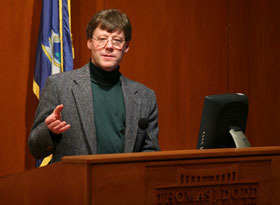  |
| HOME | THIS ISSUE | CALENDAR | GRANTS | BACK ISSUES | < BACK | NEXT > |
Ornithologist David Sibley describes lifelong study of birdsby Carol Davidge - April 23, 2007 | ||||
| Ornithologist David Allen Sibley has “interviewed” thousands of birds as his way of learning about them and drawing them. His approach has produced today’s most respected guides to birds in North America. Sibley began bird watching in California as a child with his ornithologist father, Fred. He never knew what might await him when he arrived home from school. At different times, a Western Grebe paddled in the bathtub, two Golden Eagles perched in the back yard, and a California Condor, one of the largest and rarest flying birds in the world, was in the garage. “To me that seemed perfectly normal,” said Sibley during a talk April 12 at the Thomas J. Dodd Research Center, part of the Edwin Way Teale Lecture Series. Once, in a cage on the kitchen table, newly banded and ready for release into the wild, he found a “little jewel,” a colorful Magnolia Warbler, that was the first ever recorded at Point Reyes, California. “I can still remember that special feeling of being a bird watcher, that you never know what is out there,” said Sibley. “Birds have a power unlike anything else in nature,” he said. “I’ll bet those of you with bird feeders get up in the morning and wonder what kinds of birds you’ll see in the yard. And I’ll bet none of you have the same thought about the kinds of trees you’ll find in your yard that day.” As Sibley described his journey from child bird watcher in California, to high school birder in Connecticut, to producer of nature guides in a studio in New Jersey, he displayed sketches illustrating his progress and philosophy. “I loved drawing. I liked the process of it, what it taught me about birds, and having that feeling of getting to know birds,” he said. The first image he showed was a picture of a Peregrine Falcon, which he copied out of a book at age nine. “The more I got to know about birds, the better I was able to draw them; the more I interviewed the birds, the more I learned about them,” said Sibley. He said that even for a simple line drawing, he has to look hard at the bird, “to kind of interview it, to ask questions: how long are the wings, how big is the head, what shape is the head, how does the bill connect to the head, how long are the legs, what shape are those white markings on the wings?” He showed many sketches of a rare Hawk Owl from three sightings over 14 years. “After those different experiences, I had really gotten to know Hawk Owl – its shape, markings, how it fits together, how the feathers are patterned,” Sibley said. Sometimes he uses a structured, scientific approach, as in his drawings of two similar looking female hummingbirds, Costa’s and Black-chinned Hummingbirds. At first he couldn’t distinguish the two species, but as he drew them for four hours, the more differences he saw, such as the shape of the bill, head, and wings, length and posture of the neck, and length of tail compared with body length.
A similar process with six species of flying warblers revealed differences in wing shape and body proportion, especially those of the Blackpoll warbler’s long, torpedo-shaped body. “The Blackpoll is by far the longest-distance warbler migrant,” he said. “They take off from Massachusetts and fly nonstop 72 hours over the ocean to South America, to Venezuela, Guyana, Suriname. They have to be as efficient, as streamlined, as aerodynamic as possible.” The physique of the rounder-bodied warblers, on the other hand, indicates that their migrations are shorter. Sibley began the work of creating a North American guide in 1994. The Sibley Guide to Birds was published in 2000, followed by The Sibley Guide to Bird Life and Behavior, and other guides. These successes took 30 years and thousands of “interviews,” he said. “My drawings come from a lifetime of studying and sketching.” He encouraged the audience to watch birds for excitement, mystery, and new things to learn, saying that birding connects people to distant and near places, the seasons, history, and changes in the environment. “Many birds are threatened now because of unsustainable, overharvesting of resources,” he said. “Nobody consumes more than Americans. If the rest of the world adopted the lifestyle of the average U.S. citizen, it would take four more earths to provide all the resources we consume.” Sibley noted that within a week, Rose-breasted Grosbeaks would arrive in Connecticut from Mexico and Guatemala, as they have for hundreds of years. By contrast, the Loggerhead Shrike essentially disappeared from Connecticut in the 1970s, due to loss of habitat. “We see the threat from habitat loss with species like Spotted Owl in the Pacific Northwest, Sage Grouse in the mountainous West, California Gnatcatcher in the coastal chapparal of southern California, and Red-cockaded Woodpecker in the longleaf pine forests in the southeast,” he said. “We need to live in a more sustainable way,” he urged. If we do, then hopefully our children and grandchildren will be able to enjoy the Rose-breasted Grosbeaks as they return in the spring. |
| ADVANCE HOME UCONN HOME |

